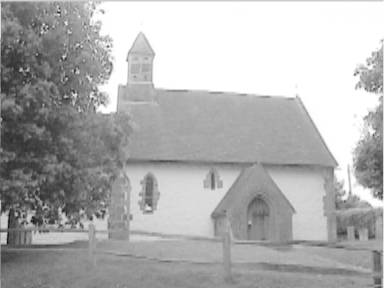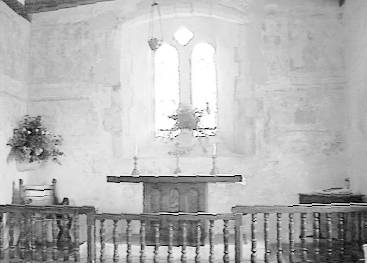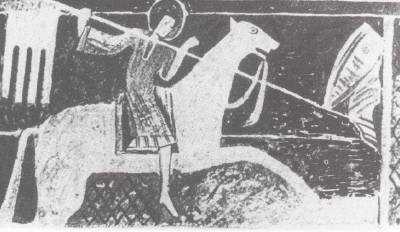![]()

![]()
29. St Botolph's, Hardham

About two miles south of Pulborough on the Arundel road, hidden behind some trees, stands the small white-washed Saxon church of St Botolph's with its wooden belfry perched so neatly in the centre of the roof. Some extra windows were added in the sixteenth century to provide more light.
From the outside the building appears plain and simple but the interior is astounding for a series of extraordinary medieval wall paintings covering the whole of the church, resembling a twelfth century art gallery. They date from c.1200 and are some of the earliest wall paintings to survive in England. They were probably painted by a travelling group of artists known as the Lewes Group. Other paintings can be seen at Clayton, Coombes and Plumpton and it seems likely that the great Cluniac priory at Lewes sponsored them. At some time in the past all the paintings were covered in plaster. They only began to be uncovered again in 1866, though most of the chancel paintings remained hidden until 1950.

The nave paintings are in two tiers with the upper tier being best preserved. Those on the East wall of the nave start the sequence with scenes showing the Annunciation and the Visitation. Along the South Wall can be seen the Nativity, the angels appearing to the Shepherds, the Journey of the Magi and Herod ordering the Massacre of the Innocents. The story continues along the upper tier of the North Wall with scenes depicting the Adoration of the Magi, the Dream of Joseph, the Dream of the Magi, the Flight into Egypt and the Massacre of the Innocents.
The lower tier pictures again start on the East Wall with scenes showing Christ among the Doctors and the Baptism in the Jordan. The South Wall shows the story of Dives and Lazarus. The North Wall tells the dramatic story of St George (the original church being dedicated to him). St George is shown mounted on a white horse, with a white banner hanging from his lance, charging the Infidel. A naked figure with bleeding wounds lies beneath the horse. This scene is believed to relate to the Battle of Antioch in 1098 during the First Crusade. Other graphic scenes show St George being tortured, tied to a wooden frame with an evil looking hump backed torturer standing at his side. The final painting shows St George being strapped to a huge spoked wheel. The lower tier of the West Wall shows fearsome Hell Scenes with souls being roasted in a cauldron.

St George mounted on a white horse
The Chancel paintings are more indistinct and mostly relate the story of Adam and Eve. The naked figure of Adam points to Eve who is accepting the apple from a winged serpent coiled in the trees. Other scenes show them sitting back to back hiding their nakedness and finally Eve is shown milking a large cow. The lower tiers in the chancel show scenes of the Passion and Resurrection. These include the Last Supper, the Betrayal, the Flagellation, the Holy Sepulchre and the three Marys at the Sepulchre.
There is so much to see in this beautiful church, an art gallery in itself, and it repays careful study. Fortunately a detailed booklet on the paintings is on sale in the church as well as some excellent postcards. It is to be hoped that these paintings which have suffered from problems caused by moisture and salts, can be preserved for future generations to enjoy. Before leaving don't forget to look up at the massive oak timbers in the roof of the nave.
John Symonds
![]() Return to the June 1999 Features page
Return to the June 1999 Features page
![]() return to Home page and main index
return to Home page and main index
page last updated 1 JUNE 1999